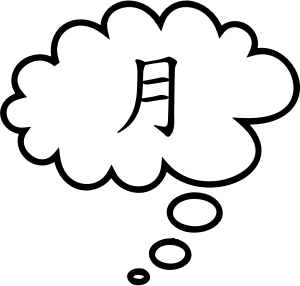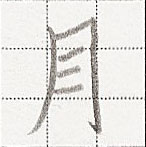 When learning to write Chinese characters, we need to remember that what we have in mind and what we actually write aren’t necessarily the same thing. In other words, what we intend to write isn’t always what comes out.
When learning to write Chinese characters, we need to remember that what we have in mind and what we actually write aren’t necessarily the same thing. In other words, what we intend to write isn’t always what comes out.
The difference is important. The goal of learning to write is mostly concerned with intent; you want to create a mental model of the language that resembles that of a native speaker. You might not be able to write a character perfectly every time, but that matters little if your intent is correct. With enough practice, you’ll be fine.
When learning to write Chinese characters, focusing on intent is key
 This idea of focusing on intent has been mentioned on Hacking Chinese earlier, in a guest article by Harvey Dam (Handwriting Chinese characters: The minimum requirements). He adds another valuable observation that shows how important intent is. If you want to write the character 月, it will come out slightly different every time, even with a perfect mental image of the character. Some strokes will be too long, others too short and so on. This is natural. However, if you have the correct mental representation, you will never write the character shown on the right.
This idea of focusing on intent has been mentioned on Hacking Chinese earlier, in a guest article by Harvey Dam (Handwriting Chinese characters: The minimum requirements). He adds another valuable observation that shows how important intent is. If you want to write the character 月, it will come out slightly different every time, even with a perfect mental image of the character. Some strokes will be too long, others too short and so on. This is natural. However, if you have the correct mental representation, you will never write the character shown on the right.
More about intent, result, mistakes and errors
The difference between intent and result can cause problems, though, because other people can’t look into your head and know what you intended to write, they can only inspect the final result. This includes teachers. If they see the incorrect 月 above, they can be pretty sure you don’t know how to write the character, but if you accidentally forget to hook the last stroke, that’s not necessarily because you didn’t know it was supposed to be hooked. To be on the safe side, teachers will treat all mistakes as errors and correct them the same way.
What’s the difference between a mistake and an error?
I have discussed mistakes and errors before (Four different kinds of mistakes: Problem analysis), but let’s look at the basic difference again:
- A mistakes is an unintentional slip. You know the right way of saying or writing something, but for some reason you failed to get it right this time. You would very likely be able to correct yourself if you got the opportunity, such as if you listen to yourself or read something you have written. Typos and slips of the tongue are typical mistakes. Native speakers make mistakes all the time. For some reason, second language learners feel much worse about slips than native speakers do.
- An error is caused by a problem in the mental model of the language you’re speaking. You think something is correct, you intend to say or write it that way, but it turns out that you’re wrong. This is much more serious, because it means you will keep on getting this wrong every time until you correct your mental model. Native speakers have very few errors. Improving your speaking and writing for second language learners is mostly about finding and correcting errors.
How does this relate to intent? It’s very straightforward: intent is directly related to your mental model (that’s what it’s based on). If your intent is correct, you might still make a mistake, but there will be no errors in your output.With practice, the number of mistakes will drop. If your intent in incorrect, you will only be able to get it right in cases where your faulty model overlaps the real one. The larger the overlap, the harder the error is to spot.
How not to learn to write Chinese characters
One of the most obvious areas of application is character writing. The first lesson and most important lesson is that you have to know what you intend to write before you write. Here are a couple of very common ways of practising characters that don’t allow you to monitor your intent properly:
- Copying characters on paper stroke by stroke – This is very bad. If you don’t have a mental model, it will take ages for it to form because you never actively rely on it to write, you just copy mechanically. You never check if you actually know the character or not, the representation of the character blocks your mental model. This method is also bad because it’s been shown that actively probing memory is much more effective than just exposing yourself to the information. Flashcards are good, in other words.
- Typing characters rather than writing them by hand – Most input methods are phonetic, meaning that you type the pronunciation of the character or word you want to write. This means that you don’t even need to think about what the character looks like and how it’s structured before it pops up as an alternative on your screen. Typing is therefore a poor way of learning to write characters (but still very practical, of course). Since most input methods help you choose not only characters but entire words or phrases, you need to know even less about small but significant differences between characters.
- Receiving too much help – Any program or method that offers hints to the user also makes it harder to monitor your intent. If you use a program like Skritter, make sure you have raw squigs turned on, which allows you to write the entire character before you get any corrective feedback. In other programs, turn off any character tracing functions and only check your result once you have finished writing the entire character.
Below, I’m going to provide a solution to the problem, but in case you want to read more about different ways of learning to write characters, I have written two articles you will find interesting:
How focusing on intent can help you learn Chinese characters
The main goal of this article is to highlight the importance of what you intend to write before you receive any kind of feedback. Since this problem is purely in the mental domain and not directly related to what tools you use, you can take care of the problem literally without lifting a finger.
Simply visualise the whole character, component by component (or stroke by stroke) before you start writing it. If you can’t do this, you probably don’t know the character. If you tried to write it down on a piece of paper, you’ll probably get stuck. Naturally, you should be aware of the risk of cheating (intentionally or otherwise). If you want to make really sure you know a character, you have to actually write it down on a blank paper with no corrective feedback at all. You don’t need to do this all the time, but occasionally writing by hand is a good reality-check, regardless of what other tools you’re using.
